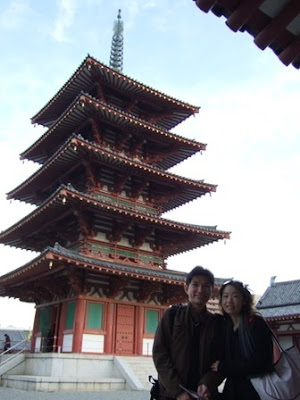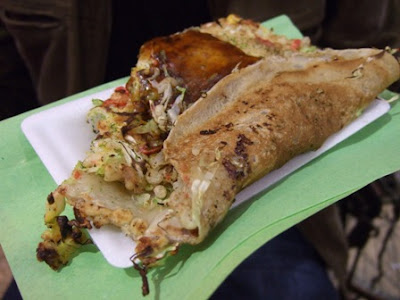After our Osaka Castle adventure, we took the subway to Shitnnojimae Yuhgaoka station in search for Shitennoji Temple.

According to the Japanese customs, the ritual cleansing of hands and mouth is required before entering the temple.

Take one of the ladles provided and fill it with fresh water

Next, rinse both hands. Transfer some water into your cupped hand and rinse your mouth. You are not supposed to transfer the water directly from the ladle into your mouth. Once the ritual is done, you can now proceed into the temple.



Built in 593 by Prince Shotoku, Shitennoji was Japan's first governmental temple, featuring a middle gate, a 5-storey pagoda, a main hall and an auditorium arranged in a straight line surrounded by corridors. We climbed up the pagoda thinking that we will get a bird-eye view of the city, only to find out that it contains the remains of the Buddha (in a form of representation).

The raked sand pavement that is off-limits to all people.

Leecher getting tired from the heavy souvenirs in his bag.


Food to the rescue once again, this time in the form of bread. The fragrant scent of freshly baked breads teased our nostrils when we stepped into the shop. They looked so enticing that we bought 4 & true enough, they are finger-licking-good!
A shopping trip to Tenjimbashisuji Shopping Street to experience the everyday life of the average Osakans.


With its unique design and a length of approx 2.6km, this arcade is the longest in Japan and is home to about 600 shops of all descriptions, including many traditional Japanese style delicatessens. Let the food/shopping feast begins!



Leecher with Doraemon's favourite snack, Dorayaki (
どら焼き, どらやき, 銅鑼焼き, ドラ焼き), which is consists of 2 small pancake-like patties made from castella wrapped around a filling of sweet red bean paste.



Okonomiyaki (お好み焼き) is a Japanese savoury snack that resemble a cross between a pancake, pizza, and omelette. The name is derived from the word
okonomi, meaning "what you like/want" and
yaki meaning "grilled/cooked". It is often referred as "Osaka soul food" as it is where this dish is said to have originated. At 130Yen a piece, I say - go for thirds or fourths!

Mister Donut! We finally crossed path again after our brief encounter in Taiwan 2 years ago. Absence makes the heart grows fonder :)

Half of our shopping loots. We had a hard time taking pictures after this as our hands were filled with bags. Time to head back to hotel to drop the stuff before venturing out to more destinations.


Where do you think we are heading to? Looks like we are taking the escalator to an unknown destination .....Looks v alien-ish!


Up we go to the Roof Top/Observation Deck located at Shin-Umeda City

Suspended 170m above the ground and connecting the twin skyscrapers of Shin-Umeda City, the Floating Garden Observatory offers unprecedented views of the city and its surrounding.
It consists of two 40-story towers that connect at their two uppermost stories, with bridges and an escalator crossing the wide atrium-like space in the center.


Night view of Osaka City

Behind us were actually lots of padlocks of love, coined as the love-lock. You purchase a heart-shaped lock, engraved your names/love messages on it and lock it on the love bar, as a symbol of eternal love.
As we descend to the ground floor, it's time to look for more food! *famished*

Ramen place near our apartment. The long opening hours ensured that our stomachs will be filled even if we get back late.


Buying the tickets for our ramen. I think the concept of having a ticket machine is quite cool ~

The shop is filled with patrons even when it was close to midnight.

Hangers for our jackets & scarfs




Hot piping & QQ ramen to warm the stomach. Every bite of the pork slice is filled with flavourful broth & tender meat. The best part: semi-running yolk oozing out from the centre of the egg, pure bliss!
 Time for lunch! A meal of tofu & udon.
Time for lunch! A meal of tofu & udon. Leecher demonstarting the 3 steps of eating tofu:
Leecher demonstarting the 3 steps of eating tofu:


